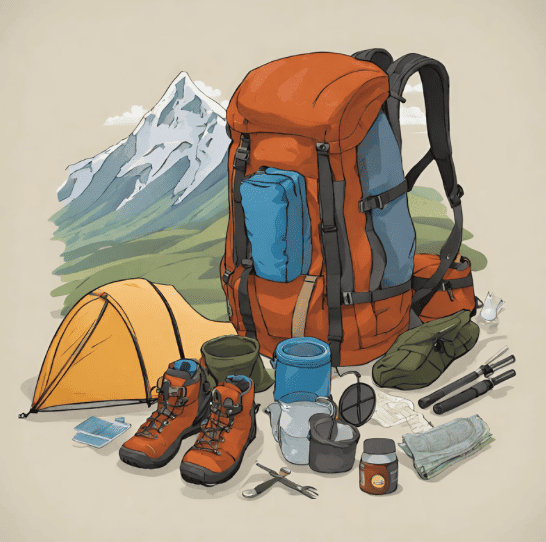
When it comes to hiking the Kungsleden trail, packing the right gear is essential for a successful and enjoyable adventure. As an avid hiker myself, I’ve learned the importance of being prepared in order to fully appreciate the stunning Swedish mountains.
In this article, I’ll share my expert advice on what to bring and why. From choosing the perfect hiking boots to packing lightweight essentials, get ready to conquer Kungsleden like a pro.
KEY TAKEAWAY
What essential items should you include in your packing list for a trek along the Kungsleden trail in Sweden?
When preparing for a Kungsleden adventure, (1) prioritize clothing suitable for varying weather conditions, including moisture-wicking layers, a warm jacket, and a waterproof shell. Additionally, don’t forget hiking boots, a comfortable backpack, a high-quality tent, a reliable map and compass, and enough food supplies for the journey. Proper planning and a well-thought-out packing list are essential to ensure a safe and enjoyable trek in this stunning Scandinavian wilderness.
Footwear First: Choosing the Right Hiking Boots and Socks for Kungsleden
Choosing the right hiking boots and socks is essential for tackling the Kungsleden. When it comes to footwear, comfort and durability are key factors to consider. The Kungsleden is a challenging trail in the Swedish mountains, so having the right gear can make all the difference in your hiking experience.
Investing in a good pair of hiking boots is crucial. Look for boots that provide ankle support and have a sturdy sole for traction on rocky terrains. Waterproof or water-resistant boots are also recommended, as you may encounter wet conditions along the trail.
In addition to boots, don’t underestimate the importance of quality hiking socks. Opt for moisture-wicking socks that will keep your feet dry and prevent blisters. Merino wool socks are a popular choice due to their breathable nature and ability to regulate temperature.
When packing for the Kungsleden, make sure to include extra pairs of socks in your backpack. It’s always wise to have backups in case your feet get wet or if you need fresh pairs during long hikes.
Transition: Now that we’ve covered footwear essentials, let’s move on to another important aspect of gear preparation: layer up! clothing for comfort and safety in the Swedish mountains.
Layer Up! Clothing for Comfort and Safety in the Swedish Mountains
When hiking in the Swedish mountains, it’s important to layer up with clothing for comfort and safety. The weather can be unpredictable, so being prepared with the right gear is essential. Here are four key items you should include in your hiking wardrobe:
- Merino Wool Base Layers: These lightweight and breathable garments are perfect for regulating body temperature. Merino wool naturally wicks away moisture, keeping you dry even during intense hikes.
- Insulating Mid Layers: Opt for fleece or down jackets that provide warmth without adding too much bulk. These layers are crucial when temperatures drop or when you take breaks along the trails.
- Waterproof Jacket: Investing in a high-quality waterproof jacket is a must for any mountain hike. Look for one that is both breathable and durable to protect yourself from rain and wind.
- Hiking Pants: Choose pants made of quick-drying materials with reinforced knees and seat areas for added durability on rugged trails.
Camping Essentials: Tent, Sleep System and More for Overnight Hiking
Don’t forget to bring a tent and sleep system for overnight hiking in order to have a comfortable and restful night’s sleep. When it comes to camping gear, these items are essential for any overnight hiking trip.
Your tent will provide shelter from the elements and give you a cozy space to retreat to after a long day on the trail. When choosing a tent, consider its weight, size, and weather resistance. Look for one that is lightweight and easy to pack, while still offering enough space for you and your gear. Make sure it is also durable enough to withstand different weather conditions.
Your sleep system includes your sleeping bag and sleeping pad. A good sleeping bag will keep you warm during chilly nights, so choose one with the right temperature rating for the climate you’ll be hiking in. A sleeping pad provides insulation from the cold ground and adds an extra layer of comfort.
As part of your packing list for overnight hiking, make sure you also include a pillow or stuff sack filled with clothes to use as a makeshift pillow. This will help ensure a good night’s sleep.
Cook, Eat, Repeat: Food and Stove Recommendations for the Trail
To prepare meals on the trail, pack a lightweight stove and choose dehydrated food options that are easy to cook and provide sufficient energy for your hiking adventures. Here are some recommendations for cooking and eating on the trail:
- Lightweight Stove: Invest in a compact backpacking stove that is fuel-efficient and easy to use. Look for models that can boil water quickly and have adjustable heat settings.
- Dehydrated Meals: Opt for dehydrated meals that are specifically designed for backpacking trips. These meals are lightweight, require minimal cooking time, and provide all the necessary nutrients you need while hiking.
- Snacks: Pack a variety of high-energy snacks such as granola bars, nuts, dried fruits, and jerky. These snacks will keep you fueled throughout the day without taking up much space in your backpack.
- Cooking Utensils: Don’t forget to bring essential cooking utensils like a pot or pan, eating utensils, a small cutting board, and a lightweight stove fuel canister.
By following these recommendations, you’ll be able to cook delicious meals on the trail while keeping your pack weight manageable.
Remember to plan your meals ahead of time and pack enough food to sustain you throughout your hike. Happy eating!
Staying Safe and Healthy: First Aid Kit and Hygiene Checklist
Make sure you include a well-stocked first aid kit and follow a hygiene checklist to stay safe and healthy on the trail. Your first aid kit should contain essential items like adhesive bandages, sterile gauze pads, antiseptic wipes, tweezers, and scissors. It’s also important to have blister pads and moleskin in case of any foot issues. I always carry lip balm with SPF to protect my lips from sunburn and chapping.
In addition to having the right medical supplies, it’s crucial to maintain good hygiene on the trail. A hygiene checklist can help you stay clean and prevent infections. Pack biodegradable soap for washing your hands and body, as well as a small towel or packable washcloth. Bring toilet paper or tissues for bathroom breaks.
If you’re prone to sprains or injuries, consider adding an elastic bandage or self-adhesive athletic tape to your first aid kit. These can provide support and stability during hikes.
Remember that prevention is key when it comes to staying safe and healthy on the trail. Taking care of blisters promptly by cleaning them thoroughly, applying blister pads, and keeping them dry will help prevent infection. Don’t forget to reapply sunscreen regularly throughout the day!
Navigation and Weather Protection: Guidebook, Map, and Rain Gear
Having a guidebook, map, and rain gear is essential for navigating the trail and protecting yourself from inclement weather. Here’s why:
- Guidebook: A reliable guidebook provides detailed information about the trail, including distances between huts, elevation profiles, and points of interest along the way. It acts as your compass, guiding you through unfamiliar terrain with ease.
- Map: While a guidebook offers valuable insights, a map is indispensable for visualizing your route and planning ahead. It allows you to gauge distances accurately, identify landmarks, and make informed decisions on where to camp or take breaks.
- Rain Gear: Kungsleden is known for its unpredictable weather patterns. Sudden rain showers can turn an enjoyable hike into a soggy mess without proper protection. Waterproof jackets, pants, and covers for your backpack will keep you dry and comfortable even in the wettest conditions.
- Navigation Tools: In addition to the guidebook and map, it’s wise to carry a compass or GPS device for precise navigation. These tools ensure that you stay on track even in low visibility situations such as fog or heavy snowfall.
Pack Smart: Saving Weight With Multi-Purpose Gear and Going Ultralight
Optimize your pack weight by choosing multi-purpose gear and embracing an ultralight approach. When it comes to packing for a hiking adventure, every ounce counts. By selecting items that serve multiple functions, you can significantly reduce the weight of your pack without sacrificing comfort or safety.
One key area to focus on is electronics. Instead of carrying multiple devices, consider investing in a lightweight battery pack that can charge your phone, camera, and other USB-powered gadgets. This eliminates the need for extra batteries and reduces overall weight.
Another way to save space and weight is by choosing a versatile rain jacket. Look for one that is not only waterproof but also breathable so you can wear it as an extra layer during chilly evenings or windy days. This eliminates the need for carrying a separate windbreaker or insulated jacket.
Lastly, be mindful of the number of clothing layers you bring. Choose lightweight materials that can be easily layered for warmth instead of packing bulky items. Remember, every item adds up when it comes to pack weight.
Conclusion
So there you have it, my fellow adventurers. We’ve covered all the essential gear for a successful trek on the Kungsleden trail. From sturdy hiking boots to warm layers and a reliable tent, we’ve got you covered.
And let’s not forget about staying safe and nourished with a well-stocked first aid kit and tasty trail meals.
But here’s the ironic twist: as much as we meticulously plan and pack, sometimes it’s those unexpected moments that truly make our journey unforgettable. So embrace the unpredictable, be prepared but also open to spontaneity, because that’s where true adventure lies.
Happy trails!
Was this helpful?

I’m Robert C. L., an associate professor of management at Washington & Jefferson College. With a Ph.D. in industrial/organizational psychology from The Ohio State University, my passion lies in exploring the realms of creativity, innovation, and the evolving landscape of work. Delving into the digital frontier, my expertise extends to the world of digital nomads, remote work, and the liberating concept of travel freedom. I’m also an author of the book “Digital Nomads: In Search of Freedom, Community, and Meaningful Work in the New Economy” which is sold on Amazon. As a dedicated mind behind timecurvesoft.com, I’m committed to unraveling the dynamics of the digital workforce and sharing insights into the future of work. Join me on this journey of exploration and discovery!